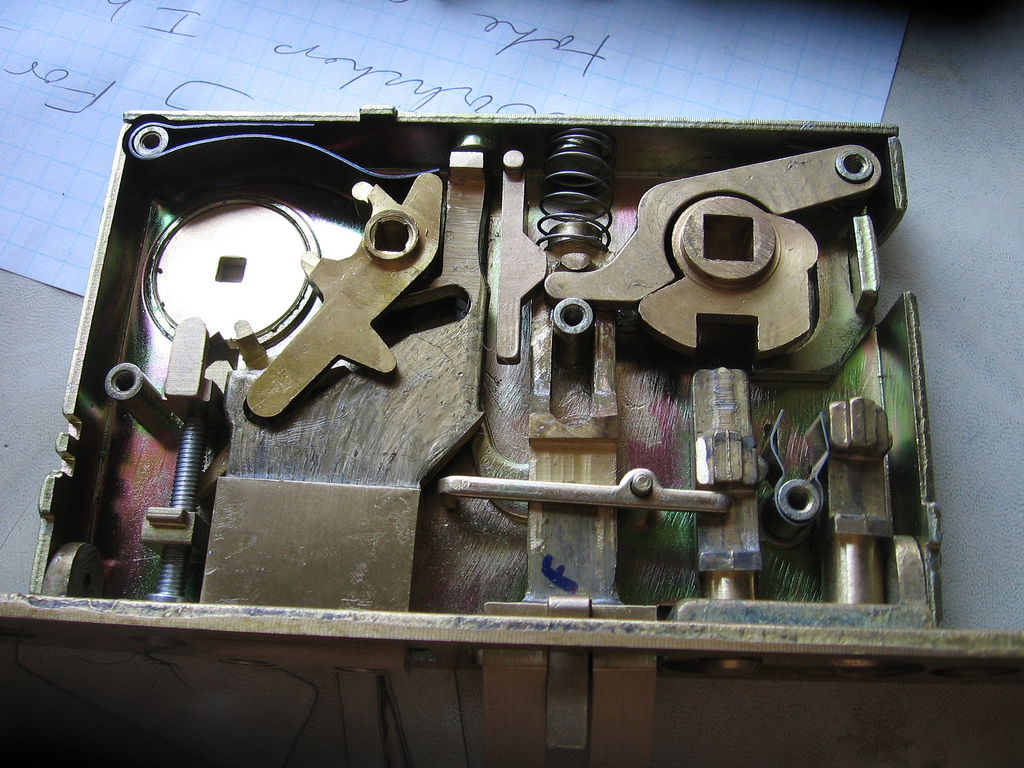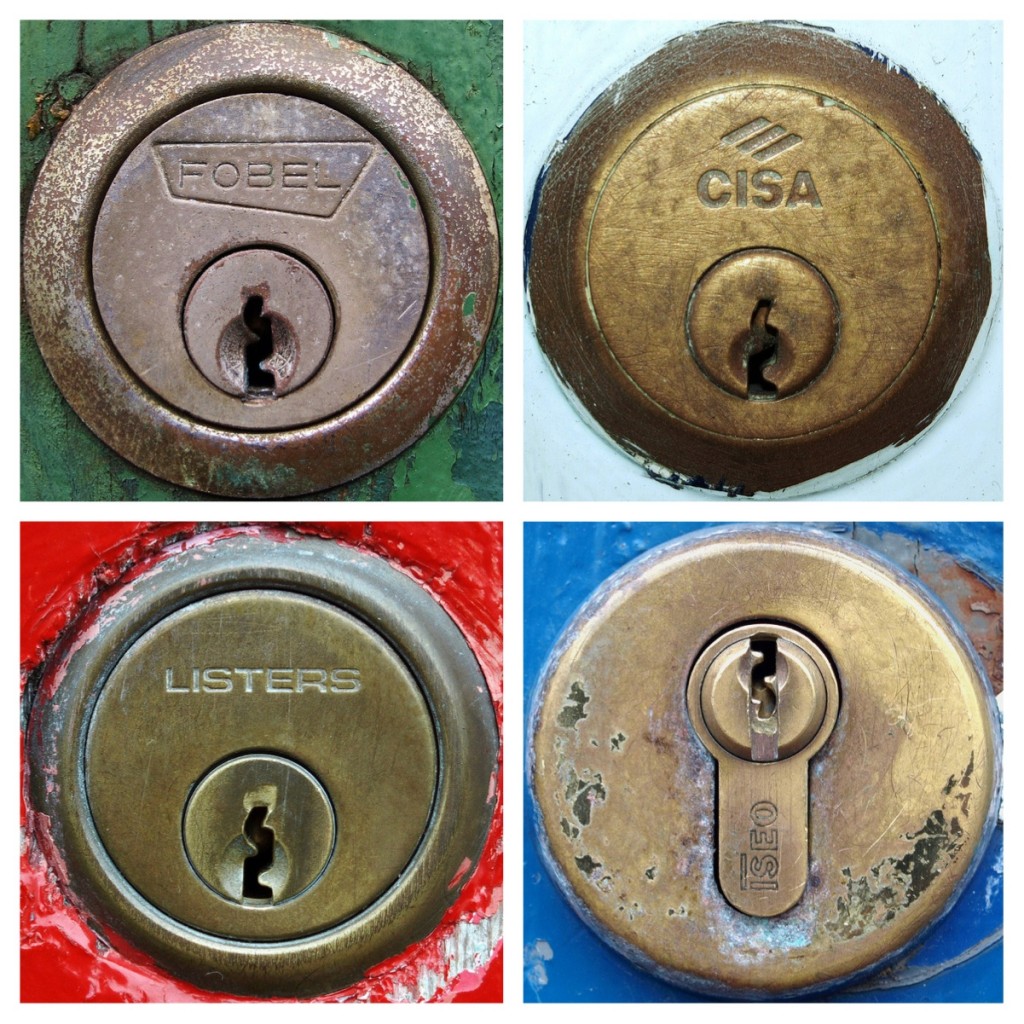The demands of commercial locks and security hardware are quite different than those of their residential counterparts. The increased need for strength, logistical flexibility, and systematic security in a commercial setting demands that business owners and commercial locksmiths make use of specific types of hardware that the average Joe might not be familiar with.
Get a better understanding of the several types of commercial locks and learn the applications best suited to each by reading our brief guide.
Mortise Locks
Although their popularity dwindled slightly during the emergence of the bored cylindrical lock at the beginning of the 20th century, mortise locks have become much more popular for commercial and high end residential applications in recent years.

Mortise locks, which require a pocket – also known as a mortise – to be cut into the door for installation, are more difficult to install, but they provide strength and versatility far superior to cylindrical locks. Additionally, they provide a standard door lock and deadbolt all in one unit. This is one reason why they are found in commercial and high end applications.
In regard to strength, mortise locks are able to accept more robust parts due to their larger internal volume, which means they can stand up to more abuse than a normal bored cylindrical lock. Their versatility stems from the fact that they have a very high rate of compatibility and interchangeability between parts from several different manufacturers.
For long-term commercial applications where high levels of strength and security are needed, mortise locks are one of the best hardware options.
Lever Handle Locks
Lever handle locks are the run-of-the-mill locks that you’re likely to see on the interior of most local businesses. Due to their lack of brute strength, lever handle locks are best suited to applications that demand security from snooping customers or thieving employees rather than forced entry from a vandal or burglar.
IC Cylinder Locks
The “IC” in the name of this type of lock stands for “Interchangeable Core,” which means that rekeying and IC cylinder lock is quite simple – no disassembling of door hardware or lock internals necessary.

For businesses that experience high turnover, or simply for those who need the capacity to rekey at a moment’s notice, IC cylinder locks are a great solution.
Keyless Locks
As keyless technology becomes more prevalent, business owners are increasingly looking for ways to implement it for maximum convenience and security. There are a few variations in keyless systems and how they grant access.
Keyless locking systems can use a fob, numerical entry code, or biometric sensor to secure any commercial space. Most pieces of keyless hardware can be outfitted with a mechanical override as well.
Keyless systems are ideal for granting tiered access to specific areas and to staff with different levels of clearance. Although keyless systems are a little more costly than their purely mechanical counterparts, they’re one of the most highly customizable commercial lock options available.
Auxiliary Locks
Not all security needs have to do with doors and room access. There are several other instances in which security hardware should be in place to prevent a breach – filing cabinets, employee lockers, etc. Auxiliary locks can be custom fitted to accommodate any such need.
Electrified Locks
Electrified locks have the distinct feature of remote and automatic control. This presents three major benefits: They can be used as a fail-safe (unlock automatically during emergency), a fail-secure (lock automatically during emergency), or simply as a remotely monitored lock controlled from a central location. Most pieces of electrified hardware are paired with a mechanical override and a request to exit control contained within the area they secure.
Electrified locks come in several different varieties, including mortise and cylindrical. They’re most often used in office, stairwell, and hallway doors in order to make a commercial building safety and security code compliant.
Photo credits:
1. Photo by Stephen Schiller
2. Photo via Flickr
3. Photo via Flickr
4. Photo via Flickr
5. Photo via Flickr

 We serve the entire Phoenix area, including
We serve the entire Phoenix area, including  We accept Cash, Checks and Major Credit Cards.
We accept Cash, Checks and Major Credit Cards.
By 6 Simple Tips To Prevent Home Break-Ins February 13, 2017 - 4:39 pm
[…] serious-looking or heavy-duty lock, like a mortise lock which has a standard lock and a deadbolt, may prevent a criminal from even trying to enter your home […]
By Olivia Pearson October 17, 2018 - 3:51 pm
I didn’t realize that commercial locks and security hardware warranted an increased need for strength, flexibility, and systematic security. I think that’s why it’s so important to find a commercial locks professional that has knowledge and experience of providing security to businesses. My friend recently started a new business, and isn’t sure how to ensure that all necessary security measures be taken. I’ll have to recommend that he find a reliable and experienced commercial locks service that can help him secure his company’s property.
By Steele Honda August 6, 2019 - 8:33 pm
Thanks for pointing out that keyless locks are one of the most highly customizable commercial lock options available. I think that if you were having trouble choosing the right locks for your business it would be smart to hire a commercial locksmith that could help you choose the right ones. I think that would help make sure that everything would be installed right and that your business could be safer and have the locks that it needed.
By The Advantages of Installing a Mortise Lock at Home? | sykinglocksmith August 15, 2019 - 3:24 pm
[…] Commercial spaces use mortise locks because of their quality and unwavering reliability. The parts for each model and brand will vary a little. Nevertheless, the design of the mortise lock can withstand use and misuse. Mortise locks are perfect for business and building that have high foot-traffic. The internal mechanism is likewise designed to be well replaceable and serviceable, which proves to be useful for new homeowners too. […]
By Tex Hooper June 9, 2021 - 12:41 am
I appreciate what you said about using keyless systems for easier access. I need a locksmith to change all of the locks on my apartment. I’ll have to consider getting a locksmith who is licensed with the state.
By Jeff Carbine February 2, 2022 - 2:07 am
I like how you mentioned that the insistence of professional locks and security hardware is quite distinct from those of their residential counterparts. My uncle is doing a patio project along with his backyard. He was asking me where to buy materials like for his tools. I will be sharing this post as his reference in looking for materials for his patio project.
By Access Doors and Panels April 29, 2022 - 6:05 am
It’s a big convenience to have this information readily available. I am grateful that you shared this helpful information with us.
By Braden Bills January 10, 2023 - 2:48 pm
My friend wants to make sure that his business is safe from robberies. It makes sense that he might want to get high quality locks installed for it! That seems like a great way to ensure that criminals can’t get in.